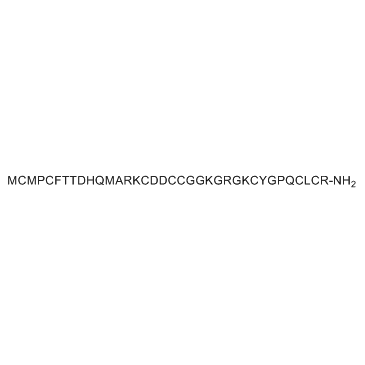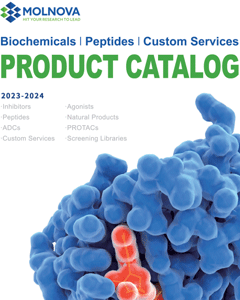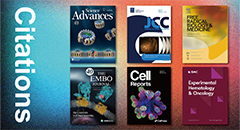
Chlorotoxin
CAS No. 163515-35-3
Chlorotoxin( TM-601 )
Catalog No. M12463 CAS No. 163515-35-3
Chlorotoxin is a 36-amino acid peptide found in the venom of the deathstalker scorpion (Leiurus quinquestriatus).
Purity : >98% (HPLC)
 COA
COA
 Datasheet
Datasheet
 HNMR
HNMR
 HPLC
HPLC
 MSDS
MSDS
 Handing Instructions
Handing Instructions
| Size | Price / USD | Stock | Quantity |
| 100MG | Get Quote | Get Quote |


|
| 200MG | Get Quote | Get Quote |


|
| 500MG | Get Quote | Get Quote |


|
| 1G | Get Quote | Get Quote |


|
Biological Information
-
Product NameChlorotoxin
-
NoteResearch use only, not for human use.
-
Brief DescriptionChlorotoxin is a 36-amino acid peptide found in the venom of the deathstalker scorpion (Leiurus quinquestriatus).
-
DescriptionChlorotoxin is a 36-amino acid peptide found in the venom of the deathstalker scorpion (Leiurus quinquestriatus); blocks small-conductance chloride channels.Brain Cancer Phase 2 Clinical.
-
In VitroChlorotoxin (Chlorotoxin) preferentially binds to tumor cells and has been harnessed to develop an imaging agent to help visualize tumors during surgical resection. In addition, chlorotoxin has potential as a vehicle to deliver anti-cancer drugs specifically to cancer cells. Chlorotoxin is shown to bind glioma cells, but is unable to bind normal rat astrocytes and Te671, a human rhabdomyosarcoma cell line. Chlorotoxin inhibits the migration of U251MG (glioma) cells, with an IC50 of 600 nM. Chlorotoxin binds to glioma cells is specific and involves high affinity (Kd=4.2 nM) and low affinity (Kd=660 nM) binding sites.Small conductance chloride channels are shown to be potently blocked by Chlorotoxin. Chlorotoxin has been used as a general pharmacological tool to investigate the function of chloride channels.
-
In VivoChlorotoxin shows insecticidal activity on insects and other invertebrates. After the administration of I-Chlorotoxin to tumor-bearing mice, the peptides accumulated within the tumor.Chlorotoxin selectively accumulates in the brain of tumor-bearing mice with calculated brain: muscle ratios of 36.4% of injected dose/g (ID/g), as compared to 12.4%ID/g in control animals.
-
SynonymsTM-601
-
PathwayMembrane Transporter/Ion Channel
-
TargetChloride Channel
-
RecptorChloride Channel
-
Research AreaCancer
-
IndicationBrain Cancer
Chemical Information
-
CAS Number163515-35-3
-
Formula Weight3995.71
-
Molecular FormulaC158H249N53O47S11
-
Purity>98% (HPLC)
-
SolubilityDMSO
-
SMILESCC(C)CC(C(=O)NC(CS)C(=O)NC(CCCNC(=N)N)C(=O)O)NC(=O)C(CS)NC(=O)C(CCC(=O)N)NC(=O)C1CCCN1C(=O)CNC(=O)C(CC2=CC=C(C=C2)O)NC(=O)C(CS)NC(=O)C(CCCCN)NC(=O)CNC(=O)C(CCCNC(=N)N)NC(=O)CNC(=O)C(CCCCN)NC(=O)CNC(=O)CNC(=O)C(CS)NC(=O)C(CS)NC(=O)C(CC(=O)O)NC(=O)C(CC(=O)O)NC(=O)C(CS)NC(=O)C(CCCCN)NC(=O)C(CCCNC(=N)N)NC(=O)C(C)NC(=O)C(CCSC)NC(=O)C(CCC(=O)N)NC(=O)C(CC3=CNC=N3)NC(=O)C(CC(=O)O)NC(=O)C(C(C)O)NC(=O)C(C(C)O)NC(=O)C(CC4=CC=CC=C4)NC(=O)C(CS)NC(=O)C5CCCN5C(=O)C(CCSC)NC(=O)C(CS)NC(=O)C(CCSC)N
-
Chemical NameL-Argininamide, L-methionyl-L-cysteinyl-L-methionyl-L-prolyl-L-cysteinyl-L-phenylalanyl-L-threonyl-L-threonyl-L-α-aspartyl-L-histidyl-L-glutaminyl-L-methionyl-L-alanyl-L-arginyl-L-lysyl-L-cysteinyl-L-α-aspartyl-L-α-aspartyl-L-cysteinyl-L-cysteinylglycylgl
Shipping & Storage Information
-
Storage(-20℃)
-
ShippingWith Ice Pack
-
Stability≥ 2 years
Reference



-
NS1652
NS1652 is an anion conductance inhibitor. NS1652 blocks chloride channel has an IC50 of 1.6 μM in human and mouse red blood cells.NS1652 (20 μM) fully and reversibly inhibits the red cell Cl-conductance. NS1652 effectively inhibits the chloride conductance (IC50, 1.6 μM) in human and mouse red blood cells, but only weakly inhibits VRAC (IC50, 125 μM) in HEK293 cells. NS1652 markedly blocks the NO production (IC50: 3.1 μM in BV2 cells).
-
Endovion
Endovion is a pharmacological anion channel and an Anoctamin-1 (ANO 1) channel inhibitor. Endovion is also the specific VRAC/VSOAC blocker.
-
IAA-94
IAA-94 is an indanyloxyacetic acid (IAA) inhibitor of epithelial chloride channels that binds channels in bovine kidney cortex microsomes with Ki of 1 uM.



 Cart
Cart
 sales@molnova.com
sales@molnova.com


